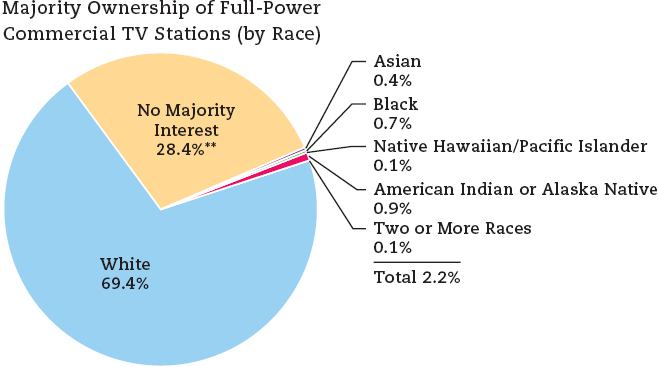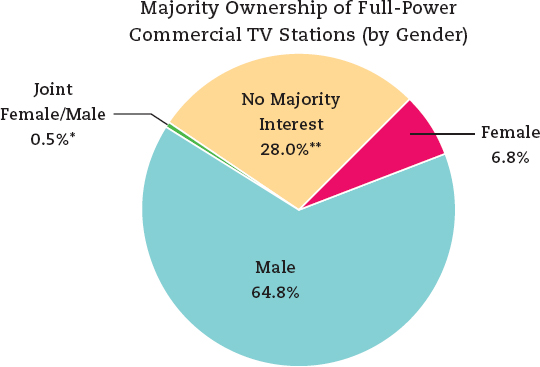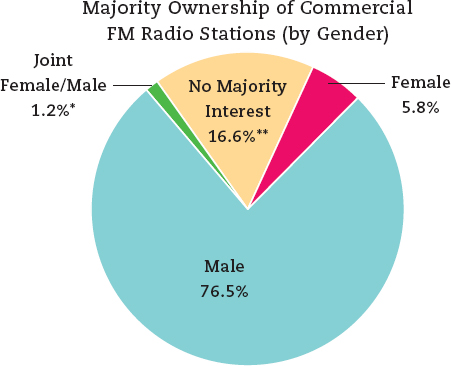Case Study
CASE STUDY
Minority and Female Media Ownership: Why Does It Matter?
The giant merger in 2010 between “Big Network” (NBC) and “Big Cable” (Comcast) signaled a key economic strategy for traditional media industries in the age of the Internet. By claiming that “Big Internet” companies like Google and Amazon (especially as they move into content development) pose enough of a threat to old media, traditional media companies pushed for the dissolution of remaining ownership restrictions. However, the big NBC-Comcast merger also brought to the forefront concerns about diminishing diversity in media ownership. Since the Telecommunications Act of 1996, which made it easier for big media companies to consolidate, minority and female media owners have declined precipitously. For example, the nonpartisan media activist group Free Press found that by 2013, “racial or ethnic minorities currently own 43, or 3.2 percent of all the U.S. full-power commercial broadcast television stations.”1 Critics fear that large media conglomerations and more consolidation will mean even less diversity in media ownership.


Source for all chart data: Federal Communications Commission, “Report on Ownership of Commercial Broadcast Stations,” DA 12-1667, November 14, 2012.
* “Joint female/male” cases are those in which a female and male each control a 50-percent interest in the station.
** “No majority interest” cases are those in which no party owns 50 percent (a majority) or more controlling interest in a station.
Back in the 1970s, the FCC enacted rules that prohibited a single company from owning more than seven AM radio stations, seven FM radio stations, and seven TV stations (called “the 7-7-7 rule”). These restrictions were first put in place to encourage diverse and alternative owners–and, therefore, diverse and alternative viewpoints. However, the rules were relaxed throughout the 1980s, and when almost all ownership restrictions were lifted in 1996, big media companies often bought up smaller radio and TV stations formerly controlled by minority and female owners. For example, by 2013, radio behemoth Clear Channel owned 840 radio stations, Cumulus owned 525, and CBS controlled 126.
In a country in which women constitute slightly more than 50 percent of the population, blacks are about 13 percent of the population, and Hispanics/Latinos are more than 16 percent of the population, television and radio broadcasting ownership diversity in the United States is poor by any measure (see pie charts).

The Free Press, in its formal response to the FCC’s 2012 report on ownership, argued that “the level of female and minority ownership in the broadcast marketplace is disproportionately and embarrassingly low,” with “a nearly 20 percent decline in the level of minority ownership since 2006.”2 The group criticized the FCC for not taking its obligations to serve the public interest seriously by not fully studying the impact that relaxed ownership rules have on minority and female broadcast station ownership. (In its own calculations, the Free Press found even lower levels of diversity in station ownership.) They contended that large chains have enormous power in the marketplace and ultimately harm minority and female ownership:
As markets become more concentrated, artificial economies of scale are created. This drives away potential new entrants in favor of existing large chains. Concentration also has the effect of diminishing the ability of existing smaller station groups and single-station owners to compete for both advertising and programming contracts. These effects combine to create immense pressure for smaller owners to sell their stations. And this destructive cycle disproportionately impacts women and minority owners, as they are far more likely to own just a single station in comparison to their white-male and corporate counterparts. Current female and minority owners are driven out of markets; and discrimination in access to deals, capital and equity, combined with the higher barriers to entry created by consolidation, shut out new female and minority owners.3
The only means at the FCC’s disposal to prevent further erosion of diversity in media are limitations on station ownership, according to the United States Court of Appeals, which ruled in 2011 that the “Commission had failed to consider the effect on minority ownership of the repeal” of ownership restrictions.4

The point of diversity in ownership is to increase the variety of voices in the public sphere, which the FCC is required to do as part of its mission in the public interest. Yet, there is continuing pressure applied to the FCC and Congress by large media conglomerates (such as News Corp. and the Tribune Co.) that want to grow even larger, so battle over ownership deregulation continues to be an issue worthy of close public attention. 